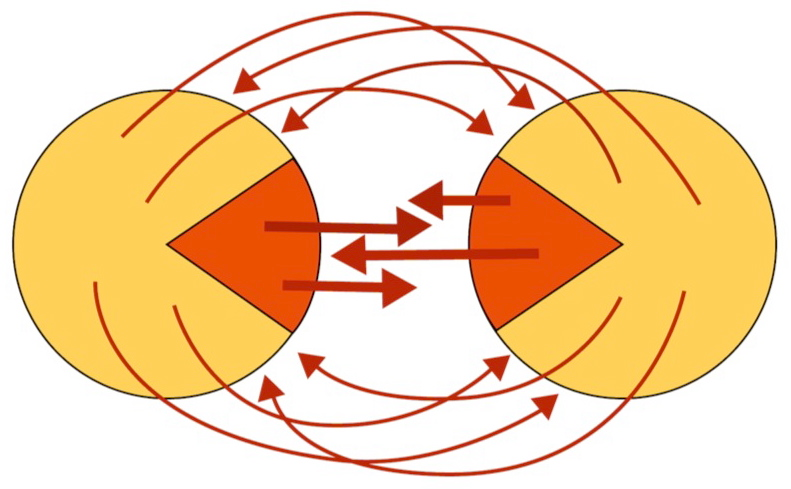
 Click here
Click hereJudicial Mediation
A judge-led mediation system has been established in Canada and Germany, on top of judge-led settlement negotiations, which is comparable to settlement negotiations in the Hearing-after-Defense process in the Netherlands. I spoke about this to judges and academics in Canada during a conference. I also attended a mediation process held in the court building, under the guidance of a judge and I spoke to the lawyers and parties involved afterwards. I also read the dissertation of Janneke van der Linden[1] about experience with judge-led mediation in Germany (Gerichtliche Mediation) and related pilot projects.
From a sustainability perspective, mediation has a great advantage over the practice of judge-led settlement negotiation of Hearing-after-Defense because the mediator must refrain from substantive involvement in the case. He or she must remain completely neutral and refrain from any opinion or advice. The role of this person is limited to facilitating the process and to encouraging the parties to engage more effectively with each other and to make use of the opportunities available to them. This approach is optimal supportive to the organic development of the ecosystems involved. Moreover the position that the mediator assumes must enable him or her to be able to apply nonviolent communication and the dialogue method of Dominic Barter which is even more supportive to the ecosystems.
By doing so the mediator optimizes the likelihood of the parties reaching a complete understanding of the position of the other party, to obtain an integral conflict solution and to reach agreements based on compassion.
Judicial mediation conducted in a courthouse, in which a judge operates as a mediator has some advantages above standard mediation. The parties go to the courthouse to mediate under the watchful eye of a judge in order to find a resolution to their conflicts on their own. Judges have a higher authority than private mediators. A request from a judge to listen to the counterparty has a much greater impact than a similar request from a regular mediator. The cachet of the court allow judges to penetrate negative patterns that exist between the parties and thereby showing the parties as real people, also in the way they perceive each other.
I attended a judicial mediation on inheritance, involving six children from a simple working background. Their mother had passed away. The children were divided into two camps that no longer trusted each other. The procedure concerned the discharge of a brother who was appointed by will as the executor. The process commenced at 09.00 AM. Various hurtful issues came out during the day in such a way that the parties felt that something had to be put right. The judge-mediator only oversaw everything that needed to be said. At 4:00 PM the brothers and sisters were joking with each other about things they had done together as children. At around 18:00 the outlines of an agreement were established, along with compensation for the sister who had taken care of the mother during her final years. Laughter was shared all around again. At 7:30 PM the agreement was established and the core of the problem between the brothers and sisters was resolved. This allowed them to sit together at the table again as they had done long ago. The balance of their personal ecosystems and their communal ecosystem had been restored through sustainable application of judicial power. Judicial authority and presence at the courthouse had served an important purpose in this case. The defense lawyer of one of the parties told me that an ordinary mediator would never have been able to bring the parties in this case together. I think that many parties require the authority of a judge to gain greater respect for each other or to find a more constructive manner to interact with each other. If the judge is then also distanced from the traditional judicial task to rule over the matter the obsession of the parties to try and convince the judge that they are right disappears altogether. This allows for calm and attention to prevail and provides room for constructive thoughts.
In Canada there is a great need for judicial mediation, however, despite the fact that normal mediation is as common there as it is in the Netherlands. The reason for this is that many parties do not have faith in a normal mediator, but they are happy to accept the authority of a judge, even if the judge will act as a mediator. Often litigating parties appear to prefer their cases to pass through a judge-led mediation process above the normal court process. Any judge-led process provides the parties with the confidence that matters will be conducted safely. It is striking that so many litigants in Canada are willing to go through mediation, provided that it happens under the guidance of a judge, and in the formal setting of a courthouse. There is also a great interest among lawyers to settle cases through judicial mediation, a very high percentage of which result in a settlement.
The success of judicial mediation can mainly be attributed to the authoritative regard (’cachet’) that judges hold. This authority allows judicial mediation to provide a setting that is very different from ordinary mediation. Judicial mediation also saves judges a lot of time as complicated, time-consuming procedures can often be taken care of in one day.
Confidentiality is an important cornerstone in Canada (Quebec). What is said during judicial mediation cannot be used in court litigation that follows if mediation should fail. The judge-mediator is then committed to refrain from any further involvement with the case. At a conference on Judicial Mediation I posed the question why confidentiality was so important and why the judge-mediator could not be involved in continuation of the case if mediation should fail. It seemed folly to me to allow a person to say one thing during mediation and then to allow the person the opportunity to change his or her statement during continuation of the case. I was told that the judges also find it equally ridiculous, but that the legal profession required this stipulation. I was told: "If we do not allow this no lawyer would be willing to cooperate with the judicial mediation process."
Sober reasoning dictates that a judge who had overseen judicial mediation would be best placed to rule over the matter as he or she would be familiar with all of the difficulties and the issues that the parties agree on. Nobody would be better equipped to put the last few pieces of the puzzle in place in order to cause minimal damage to the ecosystems of the parties. It served me well to read in the dissertation by Janneke van der Linden[2] that a pilot study had been conducted in Germany over the course of a model (that is unfortunately not well known) of ’integrated mediation’ in the context of a number of research projects into ’Gerichtsnahen Mediation’. In this model of integrated mediation a judge plays the role of a mediator during the Güteverhandlungsfase (mediation phase) and in that of a judge during the decision phase. During the Güteverhandlung phase the judge only applies mediation techniques. He only encourages parties during this stage to find a solution among themselves, without becoming too involved in the content. If the parties should fail to reach agreement (on all aspects) the same judge makes a decision on the remainder of the issues during the judgment phase.
From the perspective of sustainable justice this integrated model of judicial mediation requires further attention as this model causes the least harm to the ecosystems involved as the judge is in the best possible position to rule over aspects that the parties struggle to find common ground on.
In her thesis Van der Linden refers to a publication by A. Trossen[3], who is one of the most prominent authors in the field of integrated mediation in Germany, from which the following translated quotation is taken:
“…According to Trossen (2009) the judge must not make any settlement proposals during testing of a settlement as this would place him or her in the position of a decision maker instead of a mediator. The two roles can complement each other, however, as the judge firstly assumes the role of a mediator and only after that – when it becomes clear that the parties will not be able to reach agreement – he or she must assume the role of a decision maker.”
[1]Linden, Dr. Janneke van der (2010) De civiele zitting centraal: informeren, afstemmen en schikken,available to download for free at http://arno.uvt.nl/show.cgi?fid=114649(as on June 6, 2011), see page 175 onwards
[2]see note 7
[3]Van der Linden refers here to Trossen, A. (2009). Wege zur Kooperation. Über die moderne Führung von Vergleichsverhandlungen im streitigen, zivilgerichtlichen Verfahren. Altenkirchen: Win-Management GmbH.


